Programme delivery and reach

Key metrics

Geographical reach
The number of primary and secondary schools we worked with in Central South Wales and South West and Mid Wales are broadly representative of the number of schools in those regions.
Proportionally, we saw a smaller number of North Wales schools take part in the programme, and a higher number in South East Wales.

Regional Distribution: Percentage of Participating Schools Compared to Percentage of All Schools in Wales
Learner demographics and representation
Age of learners
Over three quarters of the learners we worked with were aged between 9 and 14, with school years 5-8 being the most popular years to deliver the programme.
Our teacher feedback shows that the programme was most popular at this age band because there is most alignment with the Welsh Curriculum. There is also more flexibility in the curriculum at this stage to deliver democratic education.
Number of Learners Worked With by Year Group
Free school meals
The average percentage of learners receiving Free Schools Meals in the primary schools we worked with was 5% points above the national average, and for secondary schools the average was 4% points below the national average.
Average Percentage of Learners Receiving Free School Meals
Black, Asian and minority ethnic learners
The average number of BAME learners in the primary schools we worked with was 22%; this is higher than the national average of 15%. For secondary schools we worked with, the average number was 11%, lower than the national average of 14%.
Average Percentage of BAME Learners
See the full list of schools we've worked with
